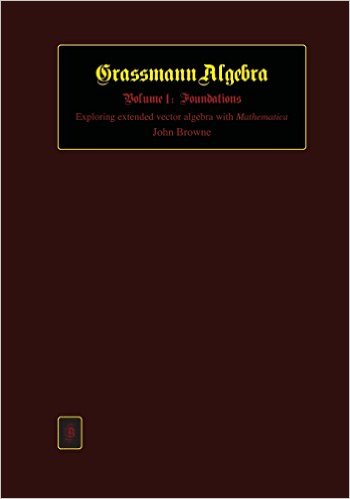
Grassmann Algebra
Provides a readable account in modern notation of Grassmann's major algebraic contributions to mathematics and science, by avoiding all mathematical terminology which does not make an essential contribution to understanding the basic concepts.
Tag(s): Linear Algebra
Publication date: 01 Jan 2001
ISBN-10: 1479197637
ISBN-13: 9781479197637
Paperback: 588 pages
Views: 22,762
Type: N/A
Publisher: CreateSpace Independent Publishing Platform
License: n/a
Post time: 18 Nov 2006 06:44:22
Grassmann Algebra
 Provides a readable account in modern notation of Grassmann's major algebraic contributions to mathematics and science, by avoiding all mathematical terminology which does not make an essential contribution to understanding the basic concepts.
Provides a readable account in modern notation of Grassmann's major algebraic contributions to mathematics and science, by avoiding all mathematical terminology which does not make an essential contribution to understanding the basic concepts.
Publication date: 01 Jan 2001
ISBN-10: 1479197637
ISBN-13: 9781479197637
Paperback: 588 pages
Views: 22,762
Document Type: N/A
Publisher: CreateSpace Independent Publishing Platform
License: n/a
Post time: 18 Nov 2006 06:44:22
John Browne wrote:All the chapters you see available here are of course protected by copyright. It is a condition of your accessing the files that you agree to use them for your own individual private study only. They may not otherwise be copied or distributed in any way in whole or in part without the permission of the author. You may reference or quote small sections of the work as long as due acknowledgment is made.
Book Excerpts:
Grassmann algebra is a mathematical system which predates vector algebra, and yet is more powerful than it, subsuming and unifying much of the algebra used by engineers and physicists. It has remained relatively unknown since its discovery over 160 years ago in Hermann Günther Grassmann's Ausdehnungslehre, yet is now emerging as a potential mathematical system for describing such diverse applications as robotic manipulators and fundamental physical theories.
The intrinsic power of Grassmann algebra arises from its fundamental product operation, the exterior product. The exterior product codifies the property of linear dependence, so essential for modern applied mathematics, directly into the algebra. Simple non-zero elements of the algebra may be viewed as representing constructs of linearly independent elements. For example, a simple bivector is the exterior product of two vectors; a line is the exterior product of two points and a plane is the exterior product of three points.
The primary focus of this book is to provide a readable account in modern notation of Grassmann's major algebraic contributions to mathematics and science. This book tries to make it accessible to scientists and engineers, students and professionals alike, by avoiding all mathematical terminology which does not make an essential contribution to understanding the basic concepts. The only assumptions for the reader's background is that they have some familiarity with basic linear algebra.
The secondary concern of this book is to provide an environment for exploring applications of the Grassmann algebra. For general applications in higher dimensional spaces, computations by hand in any algebra become tedious, indeed limiting, thus restricting the hypotheses that can be explored. For this reason the book will include a package for exploring Grassmann algebra, called GrassmannAlgebra, which has been developed in Mathematica. Readers can read the book without using the package, or use the package to extend the examples in the text, experiment with hypotheses, or explore their own interests.
Tweet
About The Author(s)
John Browne has been consulting with industry and teaching undergraduates, postgraduates, and faculty to use and apply Mathematica in their courses and research since 1991. He has lived and worked in Australia and the United States as both an engineer and an academic-- most recently as Associate Professor of Mechanical Engineering at Swinburne University of Technology in Melbourne, Australia.
John Browne has been consulting with industry and teaching undergraduates, postgraduates, and faculty to use and apply Mathematica in their courses and research since 1991. He has lived and worked in Australia and the United States as both an engineer and an academic-- most recently as Associate Professor of Mechanical Engineering at Swinburne University of Technology in Melbourne, Australia.